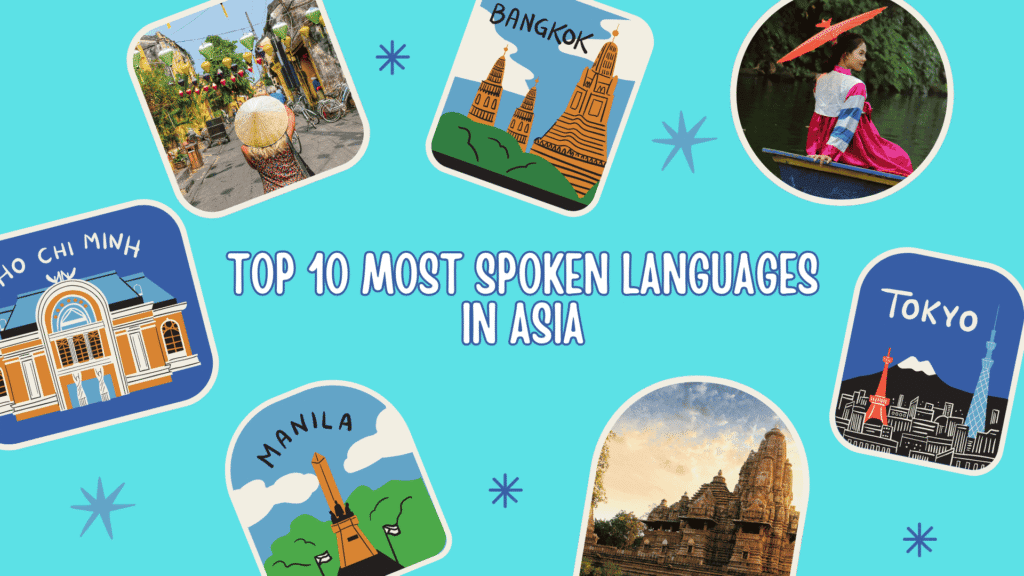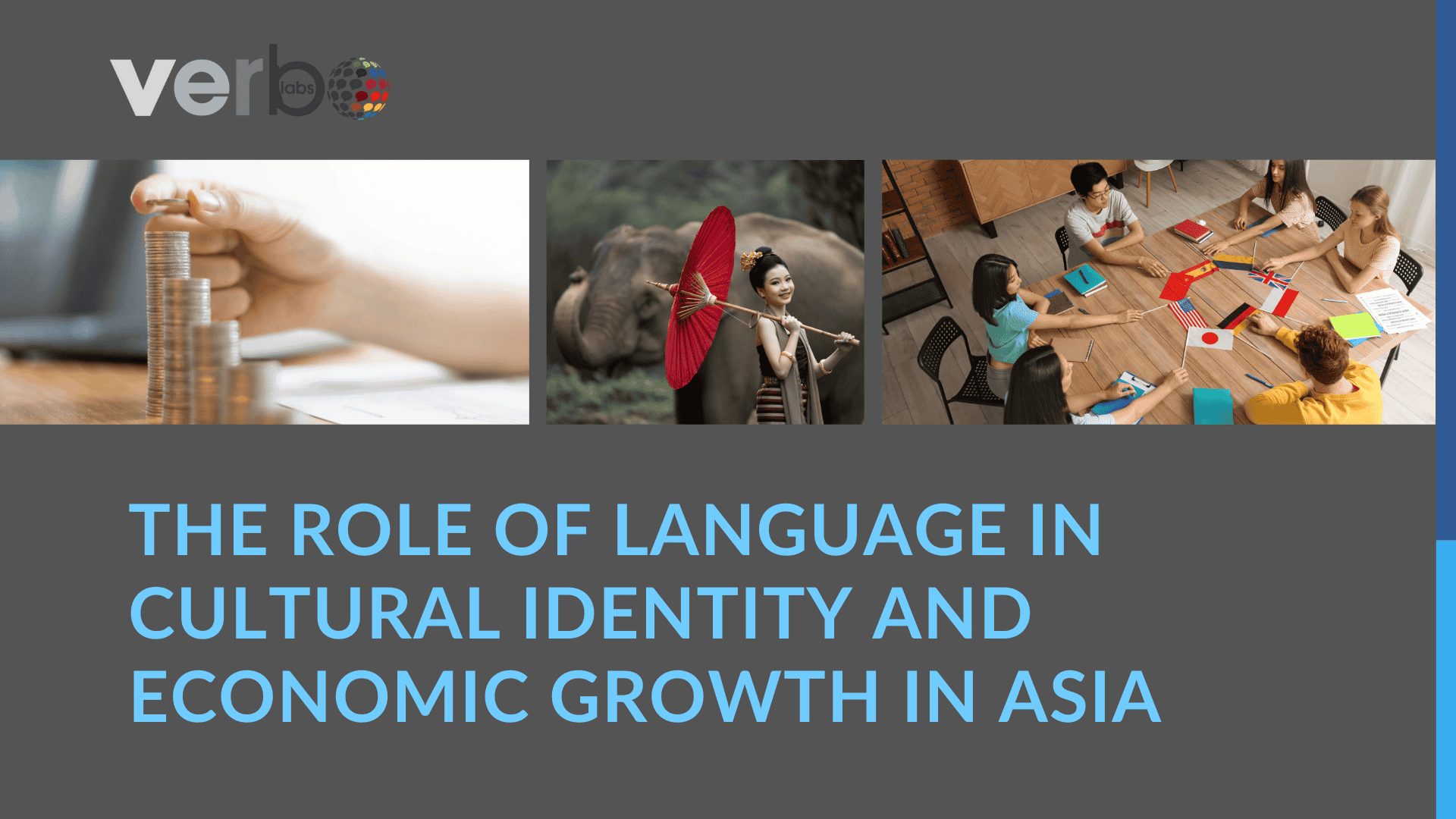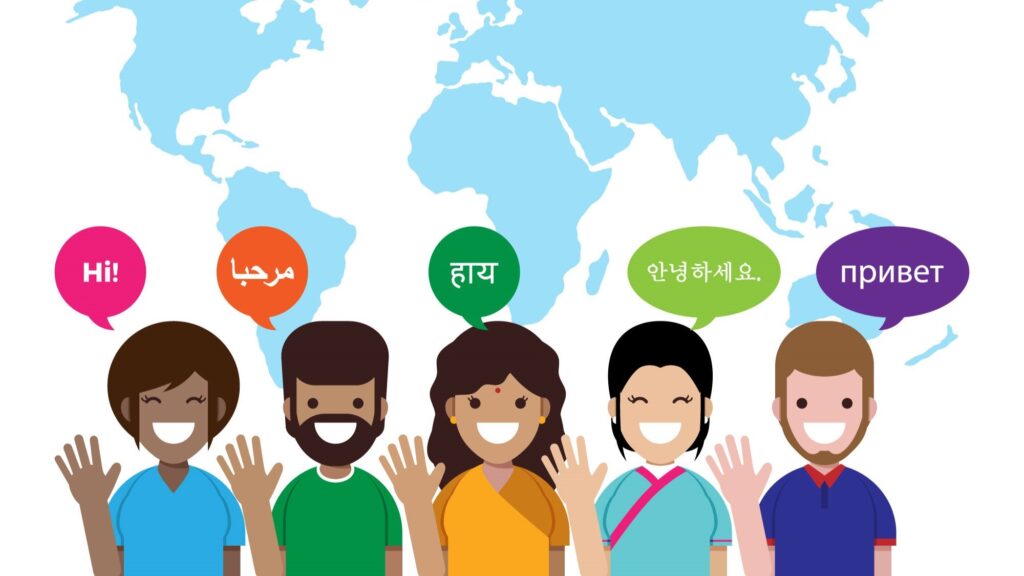
Asia, the world’s largest and most populous continent, is home to over 4.8 billion people, accounting for approximately 60% of the global population (Source Worldometer). This immense diversity is reflected in its linguistic landscape, with thousands of languages spoken across the region. Understanding the most widely spoken languages in Asia is crucial for businesses, travelers, educators, and anyone interested in the continent’s rich cultural tapestry.
In this article, we delve into the top 10 most spoken languages in Asia, examining their number of speakers, geographical distribution, and cultural significance. Whether you’re planning to expand your business, connect with new audiences, or simply learn a new language, this guide provides valuable insights into the linguistic dynamics of Asia.
The Top 10 Most Spoken Languages in Asia

1. Mandarin Chinese
Total Speakers: Approximately 1.1 billion
Key Regions: China, Taiwan, Singapore, Malaysia
Significance: As the world’s most spoken native language, Mandarin Chinese dominates the linguistic landscape of East Asia. It’s the official language of mainland China and Taiwan, and one of Singapore’s four official languages. Beyond its sheer number of speakers, Mandarin’s importance in global business, international trade, and technology sectors makes it arguably the most influential Asian language. The rise of China as an economic superpower has made Mandarin proficiency a valuable asset for multinational corporations and professionals worldwide.
2. Hindi
Total Speakers: Approximately 600 million
Key Regions: India, Nepal, Fiji, UAE, Mauritius
Significance: As one of India’s official languages, Hindi serves as a lingua franca across much of North India. With India’s growing economic significance and large diaspora communities worldwide, Hindi has become increasingly important in international business contexts. The language also dominates Bollywood, one of the world’s largest film industries, giving it substantial cultural influence. Digital content in Hindi has exploded in recent years, making it the second-most used language for internet content in Asia.
3. Bengali
Total Speakers: Approximately 300 million
Key Regions: Bangladesh, India (West Bengal, Assam, Tripura)
Significance: Bengali is the official language of Bangladesh and the second most spoken language in India. With its rich literary tradition and growing digital presence, Bengali remains vital for reaching markets in eastern South Asia. The language has a profound cultural impact through its literature, music, and cinema. For businesses targeting Bangladesh’s emerging economy or India’s eastern states, Bengali localization is essential.
4. Japanese
Total Speakers: Approximately 125 million
Key Regions: Japan
Significance: While Japanese is primarily spoken within Japan, its global influence extends far beyond its geographical boundaries. As the language of the world’s third-largest economy, Japanese plays a crucial role in the automotive, electronics, and technology industries. Additionally, Japanese cultural exports like anime, manga, and video games have created worldwide interest in the language. Japanese consumers are known for their preference for native-language content, making proper localization particularly important for this market.
5. Punjabi
Total Speakers: Approximately 125 million
Key Regions: India (Punjab), Pakistan (Punjab), Canada, UK
Significance: Spoken across the Punjab region that spans India and Pakistan, Punjabi has substantial speaker communities in diaspora countries like Canada and the UK. It’s one of the fastest-growing languages in global business contexts, particularly in industries with strong ties to these diaspora communities. The language has cultural significance through Bhangra music, Punjabi cinema, and Sikh religious texts.
6. Russian
Total Speakers: Approximately 260 million worldwide
Key Regions in Asia: Russia (Siberia), Kazakhstan, Kyrgyzstan, Uzbekistan
Significance: While often associated with Europe, Russian is also one of Asia’s major languages, serving as the primary communication tool across large portions of North and Central Asia. Russian functions as a lingua franca throughout former Soviet territories and remains essential for trade, diplomacy, and cultural exchange across Eurasia. For businesses operating in Central Asia, Russian proficiency often remains more practical than learning multiple local languages.
7. Urdu
Total Speakers: Approximately 170 million
Key Regions: Pakistan, India, UAE, UK
Significance: As Pakistan’s official language and an important language in India, Urdu has significant reach across South Asia. Its script, derived from Persian and Arabic traditions, gives it cultural connections to the broader Islamic world. Urdu’s rich poetic and literary tradition makes it culturally significant beyond its speaker numbers. The language plays a key role in South Asian business, media, and education.
8. Turkish
Total Speakers: Approximately 88 million
Key Regions: Turkey, Cyprus, Azerbaijan, parts of Central Asia
Significance: Turkish serves as a bridge between Europe and Asia, both geographically and linguistically. Its influence extends beyond Turkey into parts of Central Asia, where related Turkic languages are spoken. As Turkey’s economy has expanded, Turkish has gained importance in cross-continental business and trade.
9. Vietnamese
Total Speakers: Approximately 86 million
Key Regions: Vietnam, Cambodia, Laos, USA
Significance: As Vietnam’s economy has opened to global markets, Vietnam has become increasingly important for international business, especially in the manufacturing, technology, and tourism sectors.
10. Persian (Farsi)
Total Speakers: Approximately 80 million
Key Regions: Iran, Afghanistan (Dari), Tajikistan (Tajik)
Significance: Persian, including its variants Dari and Tajik, serves as the primary language for business and literature across significant portions of Western and Central Asia. With a literary tradition spanning over two millennia, Persian has tremendous cultural influence throughout the Islamic world.
The Role of Language in Cultural Identity and Economic Growth in Asia

Language is more than just a tool for communication—it shapes identities, preserves history, and drives economic growth. In Asia, where thousands of languages coexist, linguistic diversity plays a crucial role in both personal and national identities.
Language as a Cultural Anchor
Each language in Asia carries a rich history of traditions, literature, and oral storytelling. For example, Persian (Farsi) has influenced poetry and philosophy for centuries, while Japanese Kanji characters are deeply tied to cultural aesthetics and calligraphy. Meanwhile, languages like Hindi and Bengali continue to shape Bollywood and literary heritage, connecting millions across generations.
However, globalization has led to the decline of several indigenous languages. Many Asian governments and cultural organizations are now actively working to preserve endangered languages. India, for instance, has initiatives to protect tribal languages, while China is promoting minority languages alongside Mandarin to maintain cultural balance.
Economic Power of Language
Asia’s rapid economic growth is closely tied to language. Countries investing in multilingual education and translation services have a competitive edge in global markets. For instance, China’s dominance in technology and trade has propelled Mandarin into an essential business language. Similarly, English, though not native to many Asian countries, serves as a bridge language for trade, diplomacy, and international collaboration.
Multilingualism is also reshaping job markets. Employees who speak multiple languages, such as Mandarin, Hindi, or Japanese, are in high demand across industries like finance, technology, and tourism. Additionally, e-commerce and digital marketing have increased the need for content in local languages to engage diverse consumers.
Language is the heartbeat of Asia’s cultural and economic landscape. Embracing linguistic diversity not only preserves heritage but also unlocks new opportunities for global collaboration and economic expansion.
VerboLabs is a trusted provider of professional translation services and localization solutions, helping companies connect with audiences across 120+ languages. From website and app localization to multimedia translation, VerboLabs ensures your content is not only linguistically accurate but also culturally relevant—empowering your brand to thrive in Asia’s competitive landscape.
Conclusion
The top 10 most spoken languages in Asia represent communication channels to billions of people across the world’s most populous continent. For businesses seeking to enter or expand in Asian markets, professional translation and localization services aren’t just beneficial—they’re essential.
As global commerce continues to shift eastward, understanding and respecting Asia’s linguistic diversity will remain a key factor for international success. The companies that invest in high-quality, culturally appropriate translations will find themselves with a significant advantage in connecting with these vibrant, growing markets.

Discover how VerboLabs’ translation and localization services help you connect across Asia’s top languages.



